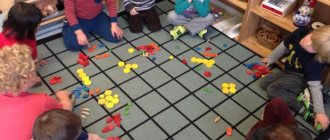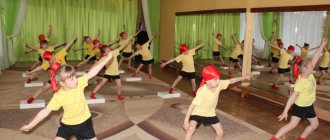How to correctly develop a summary of direct educational activities according to the Federal State Educational Standard
Dear colleagues, I offer an approximate example of a summary of direct educational activities. This does not mean that the entire country should write this way. Each region may have its own note-writing traditions . The most important thing is that the notes must reflect current trends in the development of preschoolers and be methodologically correct.
First of all, it should be noted that there is currently no clear replacement for the word “occupation”. In some regions it is called “direct educational activity” (DEA), in others – “organized educational activity” (OOA), in still others – “educational situation” (OS). All these definitions are correct, as they reflect specific educational activities. But in defense of the word “occupation,” I want to say that preschool teachers have always put a slightly different meaning into this concept than, for example, school teachers. Our lesson was held in a playful way, with various problematic situations, surprise moments and good physical activity of the pupils. There has never been a purely educational activity in kindergarten!
So, summary: 1. Title. It is not necessary to write the name of the educational activity in the title (for example, a summary of the educational activity “Visiting Parsley”). You can simply indicate the direction of activity (“Summary of direct educational activities on cognitive development”). Write the age (group) of the children (for children of senior preschool age).
2. After the title, you can indicate the priority educational area in the GCD process and, preferably, integration with other educational areas , as well as the integration of children's activities.
3. The forms of organizing collective activities are indicated (work in subgroups, in pairs, joint activities of the teacher with children) and independent activities of children (if planned).
4. Further indicate: material and equipment; preliminary work; planned results.
5. Tasks. I would like to immediately warn teachers against making mistakes. Some colleagues write: “ GCD goals This is methodologically incorrect. The goal is the final and overall result, extended over time. What goal can be achieved, for example, in 15 minutes of educational activity in a younger group? It is more correct to write the word “goal”, for example, when developing planning for a complex (i.e., several) GCD, when developing a project (since it is multifaceted) and other time-extensive complexes of educational activities . Moreover, there is only one goal, but there can be many tasks. And for a specific educational activity, specific tasks are suitable that must be solved by the end of this educational activity (after 15 minutes in the junior group or after 35 minutes in the preparatory group). That is, if a teacher wrote a problem in the GCD notes, then he must solve it in the GCD process . Therefore, do not write 10-15 problems in your notes. Five, maximum six is enough. You can replace the word “tasks” with the phrase “program content”. Do not write the verb “teach” ! It is more correct to write “to promote”, “to form skills”, “to create conditions”, “to develop”, “to involve”, etc. Tasks can be divided into 3 groups: developmental, educational, educational (educational). I would like to draw your attention to an interesting nuance: many teachers write the word “educational” instead of the word “educational”, meaning only educational tasks. But the concept of “education” (read the law “On Education in the Russian Federation”) includes both training and upbringing . This means that educational tasks will involve both teaching and educational tasks together . In this case, you will have 2 groups of tasks: developmental and educational .
6. The progress of direct educational activities. I reflected the main points of the educational activity itself in the article “How to develop a developmental lesson ,” since any educational activity according to the Federal State Educational Standard should be developmental.
Introductory part (motivational stage). The teacher must motivate children to engage in cognitive (or play) activities using a problem or play situation. This situation is described in the outline.
The main part (content, activity stage). The outline describes educational situations, problem situations, game situations, communication situations, speech exercises, didactic games, etc. In the process of these situations and games, children are given new knowledge, those already acquired are consolidated, and problematic issues are resolved.
The final part (reflective stage). In the notes, write down the teacher’s questions, with the help of which he captures new concepts and new knowledge from the students, and also helps the children analyze their own and collective activities in the process of educational activities.
Dear teachers! If you have questions about the topic of the article or have difficulties in working in this area, then write in the comments. I'll definitely help. Golovina Bela Gennadievna, site administrator.
https://detstvogid.ru/kak-pravilno-sostavit-konspekt-neposredstvenno-obrazovatelnoy-deyatelnosti-po-fgos/.html





